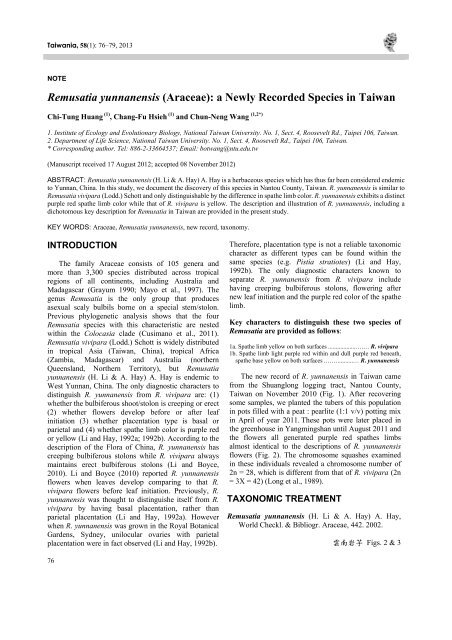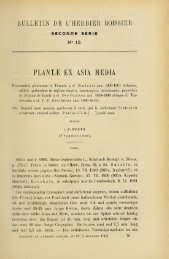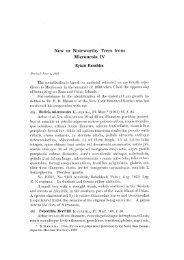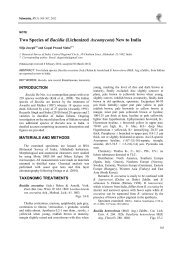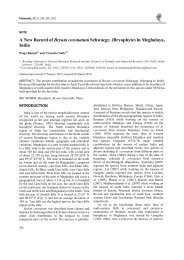Full text (PDF) - 國立臺灣大學
Full text (PDF) - 國立臺灣大學
Full text (PDF) - 國立臺灣大學
You also want an ePaper? Increase the reach of your titles
YUMPU automatically turns print PDFs into web optimized ePapers that Google loves.
Taiwania, 58(1): 76–79, 2013<br />
NOTE<br />
Remusatia yunnanensis (Araceae): a Newly Recorded Species in Taiwan<br />
Chi-Tung Huang (1) , Chang-Fu Hsieh (1) and Chun-Neng Wang (1,2*)<br />
1. Institute of Ecology and Evolutionary Biology, National Taiwan University. No. 1, Sect. 4, Roosevelt Rd., Taipei 106, Taiwan.<br />
2. Department of Life Science, National Taiwan University. No. 1, Sect. 4, Roosevelt Rd., Taipei 106, Taiwan.<br />
* Corresponding author. Tel: 886-2-33664537; Email: botwang@ntu.edu.tw<br />
(Manuscript received 17 August 2012; accepted 08 November 2012)<br />
ABSTRACT: Remusatia yunnanensis (H. Li & A. Hay) A. Hay is a herbaceous species which has thus far been considered endemic<br />
to Yunnan, China. In this study, we document the discovery of this species in Nantou County, Taiwan. R. yunnanensis is similar to<br />
Remusatia vivipara (Lodd.) Schott and only distinguishable by the difference in spathe limb color. R. yunnanensis exhibits a distinct<br />
purple red spathe limb color while that of R. vivipara is yellow. The description and illustration of R. yunnanensis, including a<br />
dichotomous key description for Remusatia in Taiwan are provided in the present study.<br />
KEY WORDS: Araceae, Remusatia yunnanensis, new record, taxonomy.<br />
INTRODUCTION<br />
The family Araceae consists of 105 genera and<br />
more than 3,300 species distributed across tropical<br />
regions of all continents, including Australia and<br />
Madagascar (Grayum 1990; Mayo et al., 1997). The<br />
genus Remusatia is the only group that produces<br />
asexual scaly bulbils borne on a special stem/stolon.<br />
Previous phylogenetic analysis shows that the four<br />
Remusatia species with this characteristic are nested<br />
within the Colocasia clade (Cusimano et al., 2011).<br />
Remusatia vivipara (Lodd.) Schott is widely distributed<br />
in tropical Asia (Taiwan, China), tropical Africa<br />
(Zambia, Madagascar) and Australia (northern<br />
Queensland, Northern Territory), but Remusatia<br />
yunnanensis (H. Li & A. Hay) A. Hay is endemic to<br />
West Yunnan, China. The only diagnostic characters to<br />
distinguish R. yunnanensis from R. vivipara are: (1)<br />
whether the bulbiferous shoot/stolon is creeping or erect<br />
(2) whether flowers develop before or after leaf<br />
initiation (3) whether placentation type is basal or<br />
parietal and (4) whether spathe limb color is purple red<br />
or yellow (Li and Hay, 1992a; 1992b). According to the<br />
description of the Flora of China, R. yunnanensis has<br />
creeping bulbiferous stolons while R. vivipara always<br />
maintains erect bulbiferous stolons (Li and Boyce,<br />
2010). Li and Boyce (2010) reported R. yunnanensis<br />
flowers when leaves develop comparing to that R.<br />
vivipara flowers before leaf initiation. Previously, R.<br />
yunnanensis was thought to distinguishe itself from R.<br />
vivipara by having basal placentation, rather than<br />
parietal placentation (Li and Hay, 1992a). However<br />
when R. yunnanensis was grown in the Royal Botanical<br />
Gardens, Sydney, unilocular ovaries with parietal<br />
placentation were in fact observed (Li and Hay, 1992b).<br />
76<br />
Therefore, placentation type is not a reliable taxonomic<br />
character as different types can be found within the<br />
same species (e.g. Pistia stratiotes) (Li and Hay,<br />
1992b). The only diagnostic characters known to<br />
separate R. yunnanensis from R. vivipara include<br />
having creeping bulbiferous stolons, flowering after<br />
new leaf initiation and the purple red color of the spathe<br />
limb.<br />
Key characters to distinguish these two species of<br />
Remusatia are provided as follows:<br />
1a. Spathe limb yellow on both surfaces ..................….… R. vivipara<br />
1b. Spathe limb light purple red within and dull purple red beneath,<br />
spathe base yellow on both surfaces .……..........… R. yunnanensis<br />
The new record of R. yunnanensis in Taiwan came<br />
from the Shuanglong logging tract, Nantou County,<br />
Taiwan on November 2010 (Fig. 1). After recovering<br />
some samples, we planted the tubers of this population<br />
in pots filled with a peat : pearlite (1:1 v/v) potting mix<br />
in April of year 2011. These pots were later placed in<br />
the greenhouse in Yangmingshan until August 2011 and<br />
the flowers all generated purple red spathes limbs<br />
almost identical to the descriptions of R. yunnanensis<br />
flowers (Fig. 2). The chromosome squashes examined<br />
in these individuals revealed a chromosome number of<br />
2n = 28, which is different from that of R. vivipara (2n<br />
= 3X = 42) (Long et al., 1989).<br />
TAXONOMIC TREATMENT<br />
Remusatia yunnanensis (H. Li & A. Hay) A. Hay,<br />
World Checkl. & Bibliogr. Araceae, 442. 2002.<br />
雲南岩芋 Figs. 2 & 3
, 2013 Huang et al.: Remusatia yunnanensis newly recorded in Taiwan<br />
Gonatanthus yunnanensis H. Li & A. Hay, Acta Bot.Yunnan.<br />
14 (4): 375. 1992. -Type: China, Yingjiang County, Li 9107<br />
(type. KUM)<br />
Seasonally dormant monoecious herbs forming<br />
bulbils or tubers, epiphytes; tubers red outside, white<br />
inside, globose, ca. 3–8 cm in diam. Bulbiferous stolons<br />
1–3, creeping or pendulous, ca. 500 × 8 mm, internodes<br />
3–6 cm long. Bulbils ellipsoid, 1–5 mm in diam.,<br />
enclosed by 8–15 hooked scales. Leaves 2–3, ovate,<br />
15–45 cm long, 10–25 cm broad, apex acuminate, base<br />
cordate, margin entire, leaf blade pale green abaxially,<br />
green adaxially; base peltate and cordate, petioles<br />
cylindrical, 20–60 cm long; primary veins 4 or 5<br />
radiating from the petioles, secondary venation arching.<br />
Inflorescences 1–3, flowering with leaves; peduncle<br />
green, cylindrical, 11–17 cm long. Spathe leathery,<br />
spathe tube green, ovate-elliptic, ca. 3 × 1.2 cm, apex<br />
strongly constricted; spathe limb initially erect, later<br />
spreading and soon reflexed, light purple red within and<br />
dull purple red beneath, base yellow on both surfaces,<br />
obovate-oblong, ca. 8.5 × 3 cm. Spadix: female zone<br />
subcylindric, ca. 15 × 6 mm, densely flowered; stigma<br />
sessile, circular; female flowers 4-carpellate; ovary<br />
1-loculed, green, ovoid, ca. 2 mm; ovules many, basal,<br />
suberect; sterile zone yellow, ca. 14 mm, slender; male<br />
zone yellow, broadly cylindrical, ca. 17 × 4 mm,<br />
attenuate toward base, apex obtuse; synandria of 4 or 5<br />
fused stamens, filament obconic, apex truncate; thecae<br />
8–10, obovoid, adnate to outside of filament and<br />
opening by a terminal pore. Fl. Aug–Oct. 2n = 28.<br />
Specimens examined: TAIWAN, Nantou County,<br />
Shuanglong logging tract, ca. 1250–1300 m in elevation, C. T. Huang<br />
1183 (TAI).<br />
Phenology: Bloom period from August to October.<br />
Distribution: Taiwan (Shuanglong logging tract) and<br />
China (Tongbiguan, Yingjiang co., Yunnan).<br />
Ecology: Moss-laden boughs, growing on tree<br />
trunks in rain forests, mountain slopes at elevation ca.<br />
1200–1300 m, mixed evergreen forests, semi-open<br />
environment, often cloudy in the afternoon.<br />
DISCUSSION<br />
One diagnostic character used for distinguishing R.<br />
yunnanensis from R. vivipara has relied on the<br />
observation that the former has creeping bulbiferous<br />
stolons whereas the latter seems to always have erect<br />
bulbiferous stolens. However, after careful examination<br />
of herbarium records and living plants of R. vivipara in<br />
the field, both creeping and erected bulbiferous stolons<br />
have been found (Fig. 4). Li and Boyce (2010) reported<br />
R. yunnanensis flowers during leaf development while<br />
R. vivipara flowers before leaf initiation. Contrary to<br />
this, herbarium specimens of R. vivipara examined in<br />
this study show that flowers may develop before or<br />
Fig. 1. Distribution map of Remusatia yunnanensis in<br />
Taiwan.<br />
during leaf development (specimen examined, KUM<br />
Tao 16931). Moreover, their flowering time overlaps<br />
according to the Flora of China (i.e. August to<br />
September in R. yunnanensis and April to September in<br />
R. vivipara flowers) (Li and Boyce, 2010). An updated,<br />
detailed comparison of the morphological characters of<br />
R. vivipara and R. yunnanensis is shown in Table 1.<br />
Our discovery of R. yunnanensis based on its purple<br />
red spathe reveals a disjunct distribution between<br />
Yunnan and Taiwan. R. vivipara rarely produces<br />
flowers in the field and no fruits with fertile seeds were<br />
found in any herbarium record. In order to induce<br />
flowering during cultivation, we raised the tubers<br />
collected from Shuangling logging tract. Intriguingly,<br />
two individual tubers had flower coloration showing<br />
purple red spathe limbs instead of yellow, as observed<br />
from the other tubers we raised. After performing a<br />
preliminary cytology check (2n = 28, see introduction),<br />
we suspect R. yunnanensis is a diploid form of R.<br />
vivipara. In support of this hypothesis, the phylogeny of<br />
Remusatia has revealed that R. vivipara and R.<br />
yunnanensis were clustered in the same group, with<br />
identical chloroplast region sequences (Li et al., 2012).<br />
Taken together, it is quite likely that R. yunnanensis is a<br />
diploid parent of the triploid R. vivipara.<br />
ACKNOWLEDGEMENTS<br />
We are grateful to Mr. Xin-Jie Hong for collecting R.<br />
vivipara. Sincere thanks to Mr. Wei-Yu Wang, who provided<br />
the photo of R. yunnanensis. We also thank Dr. Heng Li for<br />
her clear exposition of the Remusatia and the curator of KUM<br />
herbarium for facilitating specimen examination.<br />
LITERATURE CITED<br />
Cusimano, N., J. Bogner, S. J. Mayo, P. C. Boyce, S. Y.<br />
Wong, M. Hesse, W. L. A. Hetterscheid, R. C. Keating<br />
and J. C. French. 2011. Relationships within the<br />
77
78<br />
Taiwania Vol. 57, No.<br />
Fig. 2. Inflorescences of Remusatia yunnanensis. A: Purple red colored spathe limb is evident and is almost identical as type<br />
specimen of Gonatanthus yunannensis. B: Spathe limb later reflexed. Inset on top right is Remusatia vivipara with distinctly<br />
yellow colored spathe limb. Scale bar = 3 cm.<br />
Araceae: comparison of morphological patterns with<br />
molecular phylogenies. Am. J. Bot. 98: 654–668.<br />
Grayum, M. H. 1990. Evolution and phylogeny of the<br />
Araceae. Ann. Missouri Bot. Gard. Vol. 77: 628–697.<br />
Li, H. and A. Hay. 1992a. Classification of the genus<br />
Gonatanthus. Act. Bot. Yunn. 14: 373–378.<br />
Li, H. and A. Hay. 1992b. Notes on the classification of<br />
genera Remusatia and Gonathanthus in Araceae. Act. Bot.<br />
Yunn. 5(Suppl.): 27–33.<br />
Li, H. and P. C. Boyce. 2010. Remusatia (Araceae). In: Wu,<br />
Z. Y. et al. (eds.), Flora of China, Vol. 23: 71–72. Science<br />
Press, Beijing, and Missouri Botanical Garden Press, St.<br />
Louis.<br />
Li R., T. S. Yi and H. Li. 2012. Is Remusatia (Araceae)<br />
monophyletic? Evidence from three plastid regions. Int. J.<br />
Mol. Sci. 13: 71–83.<br />
Long C. L., H. Li, X. Z. Liu and Z. J. Gu. 1989. A<br />
cytogeographic study on the genus Remusatia (Araceae).<br />
Act. Bot. Yunn. 11:132–138.<br />
Mayo, S. J., J. Bogner and P. C. Boyce. 1997. The genera of<br />
Araceae. Royal Botanic Gardens, Kew, UK. 370 pp.<br />
Table 1. Comparison of morphological characters of R.<br />
vivipara and R. yunnanensis.<br />
Bulbiferous stolon erected and<br />
creeping<br />
Flower flowers before or<br />
with leaf<br />
development<br />
R. vivipara R. yunnanensis<br />
creeping<br />
flowers with leaf<br />
development<br />
Bloom period April to September August to October<br />
Type of<br />
placentation<br />
parietal basal or parietal<br />
Spathe limb color yellow purple red<br />
Chromosome<br />
numbers 2n<br />
42, 28 (SW India) 28
, 2013 Huang et al.: Remusatia yunnanensis newly recorded in Taiwan<br />
Fig. 3. Remusatia yunnanensis (H. Li & A. Hay) A. Hay. A:<br />
Plant body. B: Inflorescence. C: Bulbiferous stolon<br />
(creeping).<br />
臺灣天南星科新記錄種雲南岩芋<br />
黃啟東 (1) 、謝長富 (1) 、王俊能 (1,2*)<br />
Fig. 4. Bulbiferous stolon of Remusatia vivipara. A:<br />
Creeping stolon; B: Erect stolon. Scale bar = 3 cm.<br />
1. 國立台灣大學生態學與演化生物學研究所,106 台北市羅斯福路四段 1 號,臺灣。<br />
2. 國立臺灣大學生命科學系,106 台北市羅斯福路 4 段 1 號,臺灣。<br />
* 通信作者。Tel: 886-2-33664537; Email: botwang@ntu.edu.tw<br />
(收稿日期:2012年8月17日;接受日期:2012年11月8日)<br />
摘要:中國特有植物雲南岩芋新紀錄於臺灣南投縣。雲南岩芋與臺灣目賊芋極為相似,兩<br />
者只有在佛焰苞檐部顏色的不同,雲南岩芋的佛焰苞檐部為紫紅色,而臺灣目賊芋的佛焰<br />
苞檐部為黃色。本文並提供雲南岩芋描述、圖片與目賊芋屬之檢索表。<br />
關鍵詞:天南星科、雲南岩芋、新記錄、分類學。<br />
79


